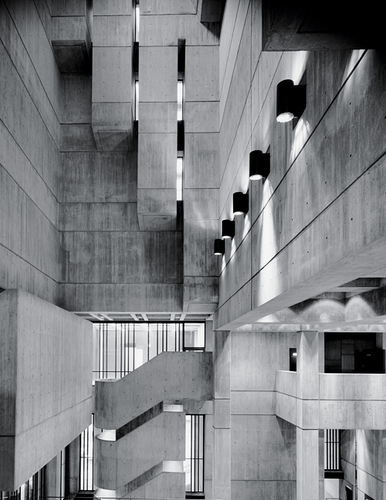Nikil Saval waxes lyrical about the resurgence of interest in Brutalism in T Magazine. He notes that Brutalism–those post-war bunker-like cement buildings that often house civic institutions–has found a friend in the internet, as Tumblrs and other blogs dedicated to the architectural style abound. Saval writes about the rise and fall and subsequent rise of Brutalism. Read him in partial below, in full via T.
IN THE RANK OF UNFLATTERING monikers for an artistic style, “Brutalism” has got to score near the top. Like the much kinder-sounding “Fauvism” or “Impressionism,” it was a term of abuse for the work of architects whose buildings confronted their users — brutalized them — with hulking, piled-up slabs of raw, unfinished concrete. These same architects, centered on the British couple Alison and Peter Smithson, enthusiastically took up Brutalism as the name for their movement with a kind of pride, as if to say: That’s right, we are brutal. We do want to shove your face in cement. For a world still climbing gingerly out of the ruins of World War II, in need of plain dealing and powerful messages, this brand of architectural honesty was refreshing.
Despite a decade or so of unexpected popularity, at least among architects and planners, Brutalism went out of favor by the mid-’70s. Films such as “A Clockwork Orange” turned Brutalist masterpieces into symbols of future dystopia. Planning budgets were slashed, and the Brutalists lost their backers. Over the last three decades, the style’s many scattered examples have suffered from age and neglect, their walls crumbling and leaking, threatened everywhere with demolition. Tom Menino, the late former mayor of Boston, proposed to sell its city hall, one of the most famous American examples of Brutalism; and in 2013, despite a fervent preservation campaign, Bertrand Goldberg’s eerie, cloverleaf-shaped, alien-eyed Prentice Women’s Hospital in Chicago succumbed to the wrecking ball.
But now, like the chevron mustache, Brutalism is undergoing something of a revival. Despite two generations of abuse (and perhaps a little because of it), an enthusiasm for Brutalist buildings beyond the febrile, narrow precincts of architecture criticism has begun to take hold. Preservationists clamor for their survival, historians laud their ethical origins and an independent public has found beauty in their rawness. For an aesthetic once praised for its “ruthless logic” and “bloody-mindedness” — in the much-quoted phrasing of critic Reyner Banham — it is a surprising turn of events.
…
THERE’S NO QUESTION that Brutalism looks exceedingly cool. But its deeper appeal is moral. In the words of Reyner Banham, it was an attempt to create an architectural ethic, rather than an aesthetic. When the Smithsons called their work Brutalist or part of a New Brutalism, the brutality to which they referred had less to do with materials and more to do with honesty: an uncompromising desire to tell it like it is, architecturally speaking. The Modern movement in architecture had supposedly been predicated on truthfulness in materials and forms, as well. But as a dreary stroll down Park Avenue will remind you, Modernism swiftly became a gutless orthodoxy, its high ideals devolving into the rote features of the International Style, a repetitive and predictable series of gestures (curtain walls or ribbon windows, recessed plinths, decorative piloti, windswept plazas, ornamental lawns and flat shimmering pools).
What was and still is appealing about Brutalism is that it had a kind of purity to it. For their first large project, a school in Hunstanton, and in subsequent projects, such as the Economist building in central London, the Smithsons went back to the lessons of the modern masters, to Mies van der Rohe and Le Corbusier: to build transparently, cleanly and truthfully. “Whatever has been said about honest use of materials,” Banham wrote in a 1955 article, “most modern buildings appear to be made of whitewash or patent glazing, even when they are made of concrete or steel.” The Smithsons’ project at Hunstanton, by contrast, “appears to be made of glass, brick, steel and concrete, and is in fact made of glass, brick, steel and concrete.”
Honesty in materials was allied to the rough, prosaic goals of social democracy. Brutalism is, as the critic Michael J. Lewis has pointed out, the vernacular expression of the welfare state. From Latin America to Europe to South Asia, Brutalism became the style for governments committed to some kind of socialism, the image of “the common good.” When the most representative building of our era is 432 Park Avenue, Rafael Viñoly’s elegant middle finger of a luxury condo tower, the tallest in the world, looming ominously over Manhattan, it is bracing to revisit a period when planners sought out the best, most avant-garde-minded architects to build libraries, city halls and public housing.
*Image of Boston City Hall by Ezra Stoller via New York Times / ESTO
